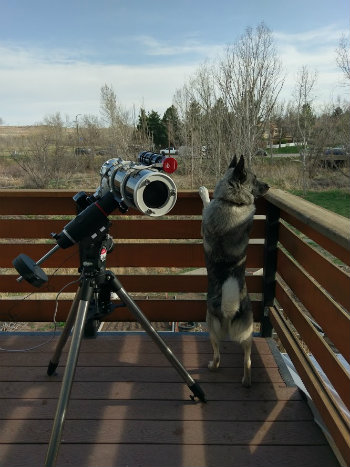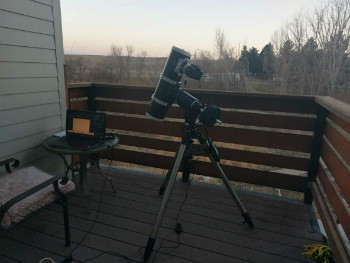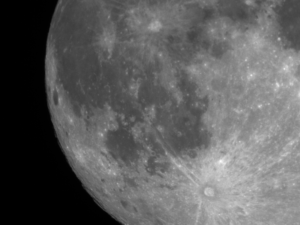Understanding Computerized German Equatorial Mounts:
The Orion Sirius is what we call an entry-level, Computerized German Equatorial Mount, or CGEM for short. A CGEM is a must-have bit of gear and the foundation of any astrophotography rig. Which is why it’s vitally important when first getting into the hobby to realize that the mount is more important than the telescope you plan to put on it.
The reason for this is tracking. In astrophotography, the goal is to lock onto one point in the sky and keep it centered in the frame for the duration of your exposures. Because some exposures can be upwards of 5-10 minutes and longer, having a mount that can consistently hold its position is critical. When a mount loses position and starts to drift, it creates star trails in the photo which ruins the shot. Not all mounts are created equal.
There are a number of factors to consider when purchasing a CGEM and one of the common beginner mistakes is to take its payload rating at face value. For visual use the rated payload is completely useable, however, the rule of thumb for astrophotography is to cut that rating in half. This number is the weight limit you can expect to load the mount with, before experiencing tracking errors and other instabilities in the system.
Another consideration is the connectivity to a computer and how it interfaces with planetarium/image acquisition software. For both visual observing and astrophotography, it is extremely useful to be able to use either a computer or cellphone app to tell the mount where to point in the sky. It is in fact nearly a necessity for astrophotography.
Knowing this basic information, let’s now take an in-depth look at the Orion Sirius.
Technical Details Of Orion Sirius EQ-G
Tripod:

The Sirius EQ-G rides on a tripod with 1.75” diameter legs and weighs in at a very manageable 43 pounds fully assembled. You may be thinking to yourself, “this doesn’t sound lightweight at all,” but considering that some mounts can weigh over 200 pounds and can only be pier mounted, the Sirius is a featherweight. The mount and tripod combined weigh 32 pounds, putting the counterweights at an easy 11 pounds each to carry and load into a vehicle when heading to dark sites.
The whole system can be broken down into three pieces for easy transport but is light enough to move assembled if used in your yard. The mount is joined to the tripod using a large threaded shaft that holds a tray that doubles as a spreader for the tripod legs. This tray has holes to store a few 1.25” eyepieces as well as one or two 2” eyepieces.
The Orion Sirius will arrive in two packages, one containing the mount head and electronics and the other containing the tripod and counterweight components. The counterweight shaft retracts into the Sirius EQ-G’s body when not in use for maximum portability.
Mount:

The mount itself is made from a cast aluminum body with machined mating surfaces and boasts a Vixen-style 8.3” dovetail mounting rail provided by default. The saddle accepts either VIxen-style or Losmandy/CGE-style dovetail plates, which is the only real mechanical difference between the Sirius and HEQ5/5i Pro from Sky-Watcher.
While speaking of threads, there are four large bolts in the body used to control Altitude and Azimuth for polar aligning. (Keep in mind the fact that the body is aluminum when adjusting bolts, as the steel bolts can and will strip the aluminum threads out of the housing if you try hard enough)
The Sirius mount comes with a built-in polar alignment scope; however, it is only usable when you rotate the declination axis to 90 degrees from the parked position, with the counterweight shaft extended. Otherwise, the view is blocked by internal obstructions, and you may be wondering why you can’t see anything through the viewfinder on the polar scope.
Be warned: the polar scope works, but is quite possibly the least impressive bit of the entire mount and can be quite challenging to use even for experienced observers. Some form of assisted polar alignment is recommended for best results with the Orion Sirius mount.
Motors:
The Sirius mount is driven by a couple of high-precision stepper motors, allowing for very accurate tracking. However, there are some key components within the drivetrain that separate this mount from other premium options.
One of those is the worm gear used to drive the mount. It has been shown in most cases to have a bit of slop in its tolerances, which introduces backlash into the system. Another area of dismay is the gears used to actually drive the two axes. These gears have been proven to have significant slop between the teeth and can cause pretty significant tracking errors if the user is not aware of it, but this is easily compensated for by the user and usually not that bad.
The good news is that the mount has a setting in the controller for backlash compensation as well as PEC learning, which, in layman’s terms, memorizes where the errors are in the system so it can adjust for them ahead of time when in actual use. Neither of these are flaws that should prevent you from purchasing this mount; however, they are good to be aware of before purchasing. There are aftermarket upgrade kits to convert the mount to a belt drive system available online.
Controllers:
The hand controller that comes with the Sirius EQ-G is the standard SynScan controller that comes with most Orion and Sky-Watcher mounts. It is an excellent controller and great for visual observation sessions. However, unless using a very basic DSLR setup for photography, most users will want to connect their mount to a PC, to control the Sirius from a planetarium software of some type.
The good news here is that the Orion Sirius can be connected directly from the hand controller or mount itself to your computer or laptop for easy target acquisition, and control of the mount for photography sessions with a third-party accessory cable available online. The mount has standardized ASCOM drivers to sync the mount with acquisition and planetarium software, and free control software (to replace the hand controller) is also available online. The Sirius mount also comes with a built-in ST-4 guiding port for direct-to-mount guiding.
Power:
The one thing to note about the Sirius EQ-G is that it does not ship with an AC power supply. So you will either need to order the available unit from Orion or use a battery box with the standard DC (cigarette lighter plug) cord that it ships with. An AC cord can be purchased separately if desired.
Using the Sirius EQ-G for Visual Astronomy & Planetary Imaging

The Sirius EQ-G is fairly easy to set up for visual use with the provided hand controller and can hold payloads up to something such as an 8” SCT, 5” refractor or 6” Newtonian reflector. Setup is fairly simple; you assemble and level the mount, balance the scope on the right ascension axis with counterweights, slide the tube forward/backward to balance the declination axis, and then polar align with the provided polar scope. After polar alignment, boot up the hand controller to go through a simple 2- or 3-star alignment and you’ll be able to slew to tens of thousands of objects in the hand controller’s internal database (a WiFi adapter to control the scope via your smartphone/tablet as with the HEQ5i Pro is available separately). The controller has a sync feature to compensate for slewing/tracking errors over time, too.
Using the Sirius EQ-G for Deep-Sky Astrophotography
For most beginners to deep-sky imaging, the Sirius EQ-G is a nearly perfect mount to start out with. It is not overly complex, it is light enough to manage in the field and simple enough to not discourage its owner from using it, all while maintaining some seriously powerful functions and tracking ability.
What does this mean? It means that as you begin your journey into astrophotography, like many of us, you will eventually start setting your sights on better, and more challenging results. The Sirius mount for many is, in essence, a “training mount” before moving on to something with a larger payload capacity, better tracking, and higher quality components. This period can last for as short as a few months, to over five years depending on your interest, skill level, and desired end results, or you may just find it’s perfect for what your interests require. However, as many go on to add secondary guide scopes, guide cameras, cooled astrophotography cameras, and all the other very specific gear required to get good astrophotos, the 15lb working payload of the Orion Sirius, quickly becomes its biggest limiting factor.
This, however, is not necessarily a bad thing. I say this because, astrophotography is very complex, and takes a long time to learn. Spending a few years on an entry-level mount will lower the barrier of entry, keep you interested, and allow you to work on all the other aspects of imaging the night sky, before feeling limited and wanting to upgrade. Or in a worst-case scenario, won’t chew up thousands of dollars that you’ll never get back if you decide not to stick with the hobby and sell the mount. The good news here is this mount holds a very high resale value if properly maintained.
If however, you happen to be looking for an entry point into the hobby, plan to be shooting on something like a lightweight 80mm refractor like the Orion ED80, or a small imaging Newtonian, you may just find that with off-axis guiding to eliminate the weight of a guide scope, the Sirius is exactly what you’re looking for.
There is no doubt the Orion Sirius is a venerable entry-level mount, but after really analyzing it, the real question becomes, “Who should purchase this mount?”
You should purchase this mount if you are:
- A visual observer, looking for a go-to mount, and your total payload is less than 30lbs.
- Just getting into astrophotography and looking for a capable budget mount.
- Planning to shoot astrophotography with a total payload of less than 15lbs.
- Expecting to be guiding, as this will drastically improve the performance of the mount.
- An experienced photographer looking for a compact, portable mount.
- Aware that at some point down the road you may become limited by the capabilities of this mount, and are okay with upgrading when that time comes.
You should not purchase this mount if you are:
- Expecting “Hubble-Like” results in your images.
- Shooting on a high focal length (above 1000mm) scope.
- Planning to mount gear weighing more than 15 lbs total for AP, or 30 lbs total for visual.
- Requiring exposure times greater than a few minutes unguided.
- Not willing to upgrade down the road.
Should I buy a Used Orion Sirius EQ-G?
If the price is right, a used Advanced VX provides even better value for the money than a new one. You should always buy a used Advanced VX – or really any GoTo mount – from a reputable seller or someone who has actually used it to be sure you are not getting a dead mount. Electronics issues can range from simple fuse and solder repairs to a dead motor board, which is usually as expensive to replace as the mount itself. Replacing the tripod is fairly straightforward, however, as are missing knobs or a broken dovetail saddle.
Alternative Recommendations
The Sirius EQ-G is the best mount in its price range other than the near-identical HEQ5i Pro, but you may want a different or heavier-duty unit depending on what you are doing.
Under $2000
- The Sky-Watcher HEQ5i Pro is often available at a slightly lower price than the Sirius and is identical apart from the exclusion of a hand controller or dual Losmandy/Vixen style dovetail saddle.
- The Sky-Watcher EQ6Ri Pro has significantly more payload capacity than the Advanced VX as well as features similar to the HEQ5i with belt drives added to its stepper motors.
- The Celestron Advanced VX is inferior to the Sirius and other belt-driven mounts for deep-sky astrophotography, but offers a beefer tripod, superior payload capacity, and a lower price for those who merely need a heavy-duty mount.
$2000+
- The Sky-Watcher AZ-EQ6i is a convertible alt-az/equatorial mount with slight bonus improvements over the EQ6Ri Pro, such as dual encoders to allow manual aiming. The Orion Atlas version is identical in operation and design.
- The Sky-Watcher AZ-EQ5i/Orion Sirius AZ/EQ-G offers similar improvements to the AZ-EQ6i over the base HEQ5i/Sirius design with belt drives, dual encoders and of course the convertible alt-az/manual mount design.


